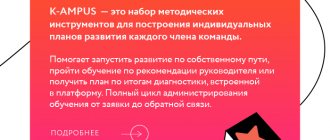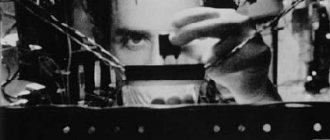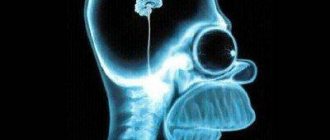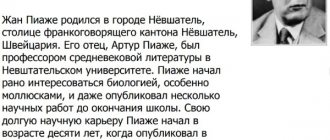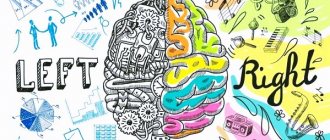In general intelligence - this is a system of mental mechanisms that determine the possibility of constructing a subjective picture of what is happening “inside” the individual.
From a psychological point of view, the purpose of intelligence is to create order out of chaos by aligning individual needs with the objective requirements of reality.
All those areas of human activity where it is necessary to learn something, do something new, make a decision, understand, explain, discover - all this is the sphere of action of the intellect.
The main theories of intelligence include:
- Psychometric theories of intelligence
- Hierarchical theories of intelligence
- Cognitive theories of intelligence
- Multiple theories of intelligence
- Gestalt psychological theory of intelligence
- Ethological theory of intelligence
- Operational theory of intelligence
- Structural-level theory of intelligence
Psychometric theories of intelligence
These theories claim that individual differences in human cognition and mental abilities can be adequately measured by special tests. Adherents of psychometric theory believe that people are born with different intellectual potential, just as they are born with different physical characteristics, such as height and eye color. They also argue that no amount of social programs can transform people with different mental abilities into intellectually equal individuals.
Psychometric theories of intelligence:
- Ch. Spearman's two-factor theory of intelligence.
- Theory of primary mental abilities.
- Cubic model of the structure of intelligence.
Ch. Spearman's two-factor theory of intelligence. Charles Spearman, an English statistician and psychologist, creator of factor analysis, he drew attention to the fact that there are correlations between different intelligence tests: those who perform well on some tests turn out, on average, to be quite successful on others. The structure of intellectual properties proposed by Charles Spearman turns out to be extremely simple and is described by two types of factors - general and specific. These two types of factors gave the name to Charles Spearman's theory - the two-factor theory of intelligence.
The main postulate of Charles Spearman's theory remained unchanged: individual differences between people in intellectual characteristics are determined primarily by general abilities.
Theory of primary mental abilities. In 1938, Lewis Thurston's work “Primary Mental Abilities” was published, in which the author presented a factorization of 56 psychological tests diagnosing various intellectual characteristics. The structure of intelligence according to L. Thurston is a set of mutually independent and adjacent intellectual characteristics, and in order to judge individual differences in intelligence, it is necessary to have data on all these characteristics.
In the works of L. Thurston's followers, the number of factors obtained by factorizing intellectual tests (and, consequently, the number of intellectual characteristics that must be determined when analyzing the intellectual sphere) was increased to 19. But, as it turned out, this was far from the limit.
Cubic model of the structure of intelligence. The largest number of characteristics underlying individual differences in the intellectual sphere was named by J. Guilford. According to the theoretical concepts of J. Guilford, the implementation of any intellectual task depends on three components - operations, content and results.
Operations represent those skills that a person must demonstrate when solving an intellectual problem.
The content is determined by the form in which the information is presented. Information can be presented in visual and auditory form, may contain symbolic material, semantic (i.e. presented in verbal form) and behavioral (i.e. discovered when communicating with other people, when it is necessary to understand from the behavior of other people how respond correctly to the actions of others).
Results - what a person ultimately arrives at when solving an intellectual problem - can be presented in the form of single answers, in the form of classes or groups of answers. While solving a problem, a person can also find the relationship between different objects or understand their structure (the system underlying them). He can also transform the final result of his intellectual activity and express it in a completely different form than the one in which the source material was given. Finally, he can go beyond the information given to him in the test material and find the meaning or hidden meaning behind this information, which will lead him to the correct answer.
The combination of these three components of intellectual activity - operations, content and results - forms 150 characteristics of intelligence (5 types of operations multiplied by 5 forms of content and multiplied by 6 types of results, i.e. 5x5x6 = 150). For clarity, J. Guilford presented his model of the structure of intelligence in the form of a cube, which gave the name to the model itself. However, the mutual independence of these factors is constantly questioned, and the very idea of J. Guilford about the existence of 150 separate, unrelated intellectual characteristics does not meet with sympathy among psychologists involved in the study of individual differences: they agree that the entire variety of intellectual characteristics cannot be reduced to one general factor, but compiling a catalog of one hundred and fifty factors represents the other extreme. It was necessary to look for ways that would help organize and correlate the various characteristics of intelligence with each other.
Test procedure
First of all, the test taker is asked to read the instructions, which describe in detail the procedure for taking the questionnaire. Then the specialists provide the person undergoing the study with a form on which he will mark the correct, from his point of view, answer options. Mandatory conditions for passing the test: calm environment; the subject is isolated from other people; The maximum time allocated for all questions is no more than thirty minutes.
Sample instructions
With the help of the questions that you can see in the test, the distinctive features of your personality and character are determined. Any of the answer options is correct, since there are different views on the same things. You need to answer as accurately and as sincerely as possible. First, you need to provide answers to four proposed questions. Based on this, you will be able to understand whether you need additional help from the study organizers.
Keep in mind that from time to time there are questions in the questionnaire for which there is only 1 correct answer. You need to remember the following 4 rules and strictly use them when taking the test:
- you need to give natural answers, those that came to your mind with lightning speed and not waste time thinking;
- it is advisable to give as few answers as possible with an average value or “I don’t know”;
- You cannot skip questions if none of the suggested answers apply to you. In this case, you need to choose the option that is closest to you. If the questions seem too intrusive and invading your personal space, please note that it is impossible to decipher the results without using a key;
- You are required to be completely honest. When taking the test, do not think about what impression you make or how you think you need to answer the questions in order to show yourself to the experimenter.
Processing the results obtained
A key is used to decipher data that is subsequently used to interpret the personal characteristics of the test taker. If the subject's answer matches the key, he is awarded a certain number of points, which are then summed up. The questionnaire uses several questions scattered in random order throughout the test to assess each factor. The sum of points for such questions ultimately gives the value of the required factor.
The research psychologist then transforms the scores into standard units or walls using special tables. After this, the specialist takes the bipolar scale and distributes the walls along it into all sixteen factors, which together form what Cattell called a personality profile.
Theories of intelligence: summary
Despite these differences, all theories of intelligence have a number of common features. They all try to take into account the biological basis of intelligence, whether it is a basic processing mechanism or a set of multiple intellectual abilities, modules or cognitive potentials.
Sources
- https://psixologiya.org/razdely/teorii/2276-teorii-intellekta.html
- https://gabysheva.ru/samorazvitie/teoriya-razvitiya-intellekta.html
- https://lifemotivation.ru/samorazvitie/teoriya-mnozhestvennyh-intellektov-gardnera
- https://ru.thpanorama.com/articles/curiosidades/las-9-teoras-de-la-inteligencia-ms-conocidas-primarias-y-modernas.html
- https://gabysheva.ru/samorazvitie/kettel-oprosnik.html
- https://knyazhinskaya.ru/chelovek/teorii-intellekta-v-psihologii-2.html
- https://ru.yestherapyhelps.com/the-triarchic-theory-of-intelligence-of-sternberg-12742
- https://miss-runet.ru/samorazvitie/obshchaya-teoriya-intellekta.html
[collapse]
Hierarchical theories of intelligence
By the beginning of the 50s, works appeared in which it was proposed to consider various intellectual characteristics as hierarchically organized structures.
In 1949, the English researcher Cyril Burt published a theoretical scheme according to which there are 5 levels in the structure of intelligence. The lowest level is formed by elementary sensory and motor processes. A more general (second) level is perception and motor coordination. The third level is represented by the processes of skill development and memory. An even more general level (fourth) are processes associated with logical generalization. Finally, the fifth level forms the general intelligence factor (g). S. Burt's scheme practically did not receive experimental verification, but it was the first attempt to create a hierarchical structure of intellectual characteristics.
The most famous hierarchical structure of intelligence in modern psychology was proposed by the American researcher Raymond Cattell. R. Cattell and his colleagues suggested that individual intellectual characteristics identified on the basis of factor analysis (such as L. Thurston’s primary mental abilities or J. Guilford’s independent factors), with secondary factorization, will be combined into two groups or, in the authors’ terminology, into two broad factors. One of them, called crystallized intelligence, is associated with the knowledge and skills that are acquired by a person - “crystallized” in the learning process. The second broad factor, fluid intelligence, has less to do with learning and more to do with the ability to adapt to unfamiliar situations. The higher the fluid intelligence, the easier a person copes with new, unusual problem situations.
Both crystallized and fluid intelligence have proven to be fairly general dimensions of intelligence that account for individual differences in performance on a wide range of intelligence tests. Thus, the structure of intelligence proposed by R. Cattell is a three-level hierarchy. The first level represents primary mental abilities, the second level represents broad factors (fluid and crystallized intelligence), and the third level represents general intelligence.
To summarize the works that proposed hierarchical structures of intelligence, we can say that their authors sought to reduce the number of specific intellectual characteristics that constantly appear in the study of the intellectual sphere. They tried to identify secondary factors that are less general than the g factor, but more general than the various intellectual characteristics related to the level of primary mental abilities. The proposed methods for studying individual differences in the intellectual sphere are test batteries that diagnose psychological characteristics described precisely by these secondary factors.
Birth sequence
Scientists have been trying for decades to understand how birth sequence affects what affects a person's intelligence. But one of the latest studies conducted by the American Psychological Association states that there is no direct relationship between the order of birth of children in a family and their level of intelligence.
Not so long ago, experts believed that it was the first-born children who showed the best results in texts testing intelligence. They explained this by the lack of competition for the attention and care of parents, which allows children to devote more time to receiving and assimilating new information. And children who were born later, according to scientists, experienced a lack of parental care and, as a result, did not show such good results on tests.
As for the latest study specifically, it compared siblings without touching on birth order. And it was possible to establish that there is no significant relationship between birth order and mental characteristics.
Cognitive theories of intelligence
Cognitive theories of intelligence suggest that a person's level of intelligence is determined by the efficiency and speed of information processing processes. According to cognitive theories, the speed of information processing determines the level of intelligence: the faster information is processed, the faster the test task is solved and the higher the level of intelligence turns out to be. As indicators of the information processing process (as components of this process), any characteristics that may indirectly indicate this process can be selected - reaction time, brain rhythms, various physiological reactions. As a rule, various speed characteristics are used as the main components of intellectual activity in studies conducted in the context of cognitive theories.
Primary intellectual abilities
According to psychologist Louis Thurstone, there are seven "primary intellectual abilities" that determine a person's intelligence: verbal comprehension, verbal fluency, numerical, spatial and inductive perception, perceptual speed and associative memory.
Storytel is an international audiobook subscription service. The Storytel library contains audiobooks of almost all genres, from classics and non-fiction to lectures, stand-ups and podcasts. This is a service that solves the reading problem. It allows you to listen to audiobooks anytime, anywhere: while working out, while cooking, on the way to and from work, on the plane, before bed, and whenever else. Storytel creates and records its own unique content - lecture projects, podcasts, audio series, and also collaborates with the best voices in the country.
Multiple theories of intelligence
The theory of multiple intelligences by the American psychologist Howard Gardner, which was first published over two decades in his book “Frames of the Mind: The Theory of Multiple Intelligences,” reveals one of the possible images of individualization of the educational process. This theory has received worldwide recognition as one of the most innovative theories of human intelligence. The theory of multiple intelligences confirms what educators deal with every day: people think and learn in many different ways.
The theory of triple intelligence. The author of this theory, American researcher Robert Sternberg, believes that a holistic theory of intelligence should describe its three aspects - internal components associated with information processing (component intelligence), the effectiveness of mastering a new situation (experiential intelligence) and the manifestation of intelligence in a social situation (situational intelligence). ). In component intelligence, R. Sternberg distinguishes three types of processes or components. Performing components are the processes of perceiving information, storing it in short-term memory, and retrieving information from long-term memory; they are also associated with counting and comparing objects. Components associated with the acquisition of knowledge determine the processes of obtaining new information and storing it. Metacomponents control performance components and knowledge acquisition; they also define strategies for solving problem situations. As research by R. Sternberg has shown, the success of solving intellectual problems depends, first of all, on the adequacy of the components used, and not on the speed of information processing. Often a more successful solution is associated with a greater investment of time.
Theory of multiple intelligences. Howard Gardner's theory, like the theories of R. Sternberg and G. Eysenck described here, uses a broader view of intelligence than that offered by psychometric and cognitive theories. H. Gardner believes that there is no single intelligence, but there are at least 6 separate intelligences. Three of them describe traditional theories of intelligence - linguistic, logical-mathematical and spatial. The other three, although they may seem strange at first glance and not related to the intellectual sphere, deserve, in the opinion of H. Gardner, the same status as traditional intellects. These include musical intelligence, kinesthetic intelligence and personal intelligence.
Musical intelligence is concerned with rhythm and hearing, which are the basis of musical ability. Kinesthetic intelligence is defined by the ability to control your body. Personal intelligence is divided into two - intrapersonal and interpersonal. The first of them is associated with the ability to manage one’s feelings and emotions, the second with the ability to understand other people and predict their actions.
Other definitions of this concept and approaches to understanding it
Let's consider other definitions of this concept.
- The broadest and most basic definition for science was given by Vernon. He defined social intelligence as a person's ability to relate to people in general, the ability to present oneself with ease in society, an understanding of social issues, sensitivity to the stimuli of other group members, an understanding of changeable moods and seeing the hidden sides of personality.
- 17 years after the first mention, psychologist G. Allport defined social intelligence as the ability to make quick judgments about people, predicting their likely reactions. Allport believed that social intelligence smoothes relationships between people.
- J. Guilford defined SQ as the ability to understand and predict people’s behavior under different circumstances, to understand intentions, feelings, and emotional states at the verbal and nonverbal levels.
Russian psychologists also asked this question.
- Thus, Emelyanov understood the term “social intelligence” as a stable, effective response and social experience based on the specifics of thinking. The ability to understand oneself and others, their relationships and the ability to make predictions regarding interpersonal events.
- V.N Kunitsyna defines social intelligence as a multidimensional complex structure - a global ability formed on the basis of complex intellectual, personal, communicative and behavioral characteristics, including the level of energy supply of self-regulation processes; together they determine the forecast of how interpersonal situations, perception of information and behavior, readiness for socialization and decision-making will develop.
- Ushakov defines social intelligence as follows:
- A special ability that is different from the rest.
- Social competence, a set of knowledge, abilities, skills acquired by a person throughout his life.
- Ushakov also emphasizes that SQ determines how successful social interaction will be.
Gestalt psychological theory of intelligence
One of the first attempts to construct an explanatory model of intelligence was presented in Gestalt psychology, within which the nature of intelligence was interpreted in the context of the problem of organizing the phenomenal field of consciousness. The prerequisites for this approach were set by W. Köhler. As a criterion for the presence of intellectual behavior in animals, he considered the effects of structure: the emergence of a solution is due to the fact that the field of perception acquires a new structure, which captures the relationships between the elements of the problem situation that are important for its resolution. The decision itself arises suddenly, based on an almost instantaneous restructuring of the image of the initial situation (this phenomenon is called insight). Subsequently, M. Wertheimer, characterizing the “productive thinking” of a person, also brought to the fore the processes of structuring the content of consciousness: grouping, centering, reorganization of available impressions.
The main vector along which the image of the situation is being restructured is its transition to a “good gestalt”, that is, an extremely simple, clear, dissected, meaningful image, in which all the main elements of the problem situation are fully reproduced, first of all, its key structural contradiction. As a modern illustration of the role of the image structuring process, we can use the well-known “four points” problem: “given four points. You need to cross them out with three straight lines, without lifting the pencil from the paper, and at the same time return to the starting point.” The principle of solving this problem is to rebuild the image: get away from the image of the “square” and see the continuation of the lines beyond the dots. In short, a distinctive feature of the involvement of the intellect in the work is such a reorganization of the content of consciousness, thanks to which the cognitive image acquires the “quality of form.”
A special place in Gestalt psychological theory was occupied by the research of K. Duncker, who managed to describe the solution to a problem from the point of view of how the content of the subject’s consciousness changes in the process of finding the principle (idea) of the solution. The key characteristic of intelligence is insight (sudden, unexpected understanding of the essence of the problem). The deeper the insight, that is, the more strongly the essential features of the problem situation determine the response action, the more intellectual it is. According to Duncker, the deepest differences between people in what we call mental giftedness have their basis precisely in the greater or lesser ease of restructuring of mental material. Thus, the ability to gain insight (that is, the ability to quickly rearrange the content of a cognitive image in the direction of identifying the main problematic contradiction of the situation) is a criterion for the development of intelligence.
Description of Cattell's technique
What is the meaning of the factor that is included in this concept? Cattell understood a factor as a combination of several superficial qualities of an individual, which can be combined under one common denominator. The questionnaire was published by its creator in 1949. Initially it included Form A and Form B, which were later supplemented with the following tests:
- Form C and Form D, introduced in 1956;
- Form E and Form F, released in 1961;
- Fourteen Factor Adolescent Questionnaire;
- Children's Twelve Factor Test;
- a shortened version for adults, designed for 13 factors.
In order to correctly interpret the results obtained, several counting algorithms are used:
- special,
- abbreviated
- simplified.
Fluid Intelligence
Which has a hereditary and biological component, with a physiological origin, capable of acting in any situation, and which reflects the ability we have to adapt to different situations or problems that arise without the need to have previous experience.
It reflects a person's basic abilities in reasoning and higher mental processes. Fluid intelligence can be measured through tests to obtain a person's ability to acquire knowledge.
Crystallized Intelligence
Complete the previous with acquired knowledge that originates in the person's experience and encompasses the cognitive abilities in which previous learning has crystallized. This intelligence is assessed through school tests and knowledge gained through interaction with the sociocultural environment.
It also links, in its neuropsychological aspect, the different relationships between the cerebral hemispheres and types of abilities.
Stages of developing a questionnaire methodology
When compiling the questionnaire at the first stage, Cattell used the works of psychologists Odbert and Allport, who were engaged in finding words in the English language that could be used to describe the distinctive character traits and behavior of an individual. Since there were a lot of such words (4.5 thousand), it is not surprising that Cattell decided to reduce their number to a reasonable value and used factor analysis to solve this problem. He divided the definitions of human character traits and behavior into groups based on their synonymy, and then chose one word that, in his opinion, most fully reflected the essence of a whole group of words.
Using this method, Cattell reduced the number of characteristics to 171 words. Then, with the help of expert psychologists, Cattell was able to cross-correlate their ratings, from which he was able to select thirty-six correlating galaxies of words that were bipolar or antonymous, for example, “happy - sad.”
Subsequently, Cattell conducted several additional studies that found that the number of bipolar couples can be reduced to sixteen factors. The significance of the knowledge gained is very great, since it contributed to the confirmation of the following psychological theories: the theory of self-control and the theory of introversion and extraversion.
Since sixteen factors were identified only using L-data, they were of little use for use in practice. The fact is that it is not possible to measure the personal characteristics of a large number of people using only L-data, because it is not economically feasible to train a significant number of experts to work with subjects.
Based on this, Cattell made a logical conclusion: it was necessary to study Q-data, which led to the emergence of other, more recent, forms of the questionnaire.
Ethological theory of intelligence
According to W. Charlesworth, a proponent of the ethological approach to explaining the nature of intelligence, the starting point in his research should be the study of behavior in the natural environment. Intelligence, therefore, is a way of adapting a living being to the requirements of reality, formed in the process of evolution. For a better understanding of the adaptive functions of intelligence, he proposes to distinguish between the concept of “intelligence,” which includes existing knowledge and already formed cognitive operations, and the concept of “intellectual behavior,” which includes means of adaptation to problematic (new, difficult) situations, including cognitive processes that organize and control behavior.
A look at intelligence from the perspective of the theory of evolution led W. Charlesworth to the conclusion that the deep mechanisms of that mental property that we call intelligence are rooted in the innate properties of the nervous system.
It is curious that the ethological approach (with its focus on the study of intellectual activity in everyday life in the context of the natural environment) brought to the fore the phenomenon of common sense (a kind of “naive theory of human behavior”). Unlike fantasy dreams and scientific thinking, common sense, on the one hand, has a realistic and practical orientation and, on the other hand, is motivated by needs and desires. Thus, common sense is situationally specific and at the same time individually specific - this is what explains its key role in organizing the adaptation process.
Introduction
The status of the problem of intelligence is paradoxical from a variety of points of view: its role in the history of human civilization, the attitude towards intellectually gifted people in everyday social life, and the nature of its research in the field of psychological science are paradoxical.
The entire history of the world, based on brilliant guesses, inventions and discoveries, testifies that man is certainly intelligent. However, the same story provides numerous evidence of the stupidity and madness of people. This kind of ambivalence in the states of the human mind allows us to conclude that, on the one hand, the ability for rational knowledge is a powerful natural resource of human civilization. On the other hand, the ability to be reasonable is the thinnest psychological shell, instantly discarded by a person under unfavorable conditions.
The psychological basis of rationality is intelligence. In general, intelligence is a system of mental mechanisms that make it possible to construct a subjective picture of what is happening “inside” an individual. In its highest forms, such a subjective picture can be reasonable, that is, it can embody that universal independence of thought that relates to every thing as required by the essence of the thing itself. The psychological roots of rationality (as well as stupidity and madness), therefore, should be sought in the mechanisms of the structure and functioning of the intellect.
Operational theory of intelligence
According to J. Piaget, intelligence is the most perfect form of adaptation of the body to the environment, representing the unity of the assimilation process (reproduction of environmental elements in the subject’s psyche in the form of cognitive mental schemes) and the accommodation process (changes in these cognitive schemes depending on the requirements of the objective world). Thus, the essence of intelligence lies in the ability to carry out flexible and at the same time stable adaptation to physical and social reality, and its main purpose is to structure (organize) a person’s interaction with the environment.
The development of intelligence is a spontaneous process, subject to its own special laws, of the maturation of operational structures (schemes) that gradually grow out of the child’s objective and everyday experience.
Consequently, intellectual development is the development of the operational structures of the intellect, during which mental operations gradually acquire qualitatively new properties: coordination (interconnectedness and consistency of many operations), reversibility (the ability at any time to return to the starting point of one’s reasoning, to move on to considering an object directly). the opposite point of view, etc.), automation (involuntariness of application), abbreviation (collapse of individual links, “instantaneity” of actualization).
List of information sources
1. Anastasi A. Psychological testing. T. 1. M.: Pedagogy, 1982. – 309 p.
2. General psychology: Under general. ed. Karpova A.V. M.: Gardariki, 2004. – 232 p.
3.Psychology. Dictionary. Under general editorship A.V.Petrovsky, M.G. Yaroshevsky. M.: Sfera, 2005 – 683 p.
4. Sidorov P.I., Parnyakov A.V. Clinical psychology. M.: GOETAR-MED, 2005. – 864 p.
5. Kholodnaya M.A. Psychology of intelligence: paradoxes of research. - Tomsk: Publishing House Vol. un-ta. M.: Bars, 1997. – 392 p.
6. Man: anatomy, physiology, psychology. Encyclopedic illustrated dictionary. St. Petersburg: Peter, 2007. – 672 p.
bibliography
Similar works
Strategic management and balanced scorecard in enterprise architecture
Management functions in the customs management system: general, specific, private
Management functions in the customs management system: general, specific, private 3
Development of an information system for organizing logistics at an enterprise 2
Managing project risks in an organization (using the example of the company “TEZ TOUR”).
The emergence of common law in England. Jury trial
Production logistics strategy for an industrial organization using the example of enterprise 2
Improving the management of the labor protection system at a transit enterprise
Stages of organizational design of a personnel management system using the example of an organization in the Moscow region
Structural-level theory of intelligence
A number of essential provisions regarding the nature of human intellectual capabilities are formulated within the framework of the theory of intelligence, developed under the leadership of B. Ananyev. The starting point was the idea that intelligence is a complex mental activity, representing a unity of cognitive functions at different levels. Within the framework of this theory, the thesis about intelligence as the effect of interfunctional connections of basic cognitive processes at different levels of cognitive reflection was developed. In particular, as part of the empirical study, cognitive functions such as psychomotor skills, attention, memory and thinking were studied, which were considered as components of the intellectual system.
Experimental studies by B. Ananyev and his colleagues allowed them to draw a number of important conclusions regarding the functional-level structure of intelligence.
B. Ananyev constantly emphasized the deep unity of the theory of intelligence and the theory of personality. On the one hand, needs, interests, attitudes and other personal qualities determine the activity of the intellect. On the other hand, the characterological properties of a person and the structure of motives depend on the degree of objectivity of his relationship to reality, the experience of knowing the world and the general development of intelligence.
0
0.5
Craniometry
In the 19th century, scientists believed that a person's intelligence could be assessed by measuring their skull and facial structure. At the very beginning of the development of this theory, the French surgeon Paul Broca made the opposite assumption: he believed that the level of intelligence was influenced by the ratio of the length of the forearm to the length of the shoulder.
The scientist tried to prove that the most intellectually developed race is the race of white people, based only on the length of the arm, but he did not succeed. Then he decided to measure the skull and facial structures to determine how large a brain could fit inside the skull of a particular person. This method seemed to him more suitable for assessment. This was called craniometry.
According to craniometry, the larger the bones of the skull, the larger the brain that is located in it, which means that a person has high intelligence. However, the methodology was subject to constant criticism: many found racial prejudice in it, and also pointed out the lack of evidence base. As a result, at the beginning of the 20th century, craniometry ceased to exist as a technique for assessing intelligence.
But it is still worth noting that research in craniometry contributed to the discovery of brain speech centers and the identification of the concepts of intellectual factor, which we all know today as IQ.
What indicator indicates “backwardness”
A person's mental abilities may be reduced. A number of symptoms indicate this:
- inability or low ability to think in abstract categories (select);
- inability to generalize and systematize received information;
- lack of critical thinking;
- the habit of thinking specifically, narrowly;
- small, poor vocabulary;
- paucity of emotions;
- increased suggestibility, knowledge;
- remarkable stubbornness.
Is it possible to improve intelligence?
Human intelligence can be adjusted, it can be improved, enriched, and developed.
Odds information
Contrary to popular belief, it is extremely difficult to measure intelligence because, as mentioned, it consists of many different abilities.
And even existing tests created by famous psychologists cannot be considered an ideal measurement method: they often measure only some of the components of intelligence.
They are convenient to use to identify people with insufficient intellectual abilities, which helps in diagnosing some diseases, but it is difficult to find geniuses with their help, since genius is also a complex structure consisting of many components.
The most well-known tests that reveal IQ are:
- Hans Eysenck test,
- Raven's test (Raven),
- Wechsler test.
Tests showing IQ levels have been repeatedly criticized by various researchers, for example, mathematician Viktor Vasiliev, who found errors in the Eysenck questionnaire.
It has also been noted that IQ level weakly correlates with the likelihood that a person will achieve success in life and be happy.
The type of intelligence that can be measured using the above tests is called psychometric . Its manifestations are quite simple to identify and record.
Data:
- It is extremely important that a person at the formation stage (during pregnancy and childhood) receives a sufficient amount of iodine . The average IQ in regions where children and pregnant women do not receive enough iodine is 10-15 points lower than in regions where this problem does not exist.
- People with a high IQ are more likely to suffer from mental illness , especially anxiety disorder.
- Marilyn vos Savant , American woman with the highest IQ in the world: 228. She is a journalist and writes books.
How to increase IQ in an adult
To make your intelligence noticeably above average, it is important to maintain active brain activity, but do it correctly:
- Solve problems, equations, add and subtract large numbers in your head.
- Train your own memory (memorize poems, song lyrics, passages of prose works).
- Follow the basic rules of a healthy lifestyle (eat right, give up bad habits, play sports, walk in the fresh air more often).
- Find a balance between work and rest, give your brain a break, get enough sleep.
- Make a healthy daily habit of reading at least a few pages a day. This makes the brain work, expands horizons, expands vocabulary, and increases the level of education.
- Find intellectual entertainment. These include visiting libraries, interesting lectures and seminars, going to museums, solving crosswords and puzzles, and reading scientific literature.
- To learn foreign languages. This trains memory and improves brain activity.
- Change your long-term habits. For example, on weekends, don’t lie on the couch in front of the TV, but go camping with tents with the whole family. In the morning, go to work a different way. Instead of the usual cutlets, cook a dish for dinner, for example, Mongolian cuisine.
- Learn new skills. If you have long wanted to learn how to dance ballroom, then you should enroll in a dance class. For those interested in history, join an archaeological group. For those who write poetry, visit the literary lounge.
Are you improving your own intelligence? What exercises do you use to do this? Share with other readers in the comments.
Intellectualization in psychology
Intellectualization , one of the forms of psychological defense in which a person closes himself off from his sensory sensations and begins to perceive what he feels on an intellectual level. This helps reduce the influence of emotions on behavior and decisions, and act more wisely and correctly.
But any protective mechanisms of the psyche negatively affect how an individual perceives reality and himself . In this case, intellectualization leads to the fact that the individual ceases to realize the importance of his emotional state.
People who actively use such defenses have difficulty expressing emotions , which complicates interaction with others, especially in the case of close social relationships (love, friendship).
It is considered an integral part of the personality of schizoids (both schizoid accentuation and schizoid personality disorder are implied).
Read about the symptoms and treatment of emotional personality disorder here.
Main functions
General intelligence performs various functions and tasks.
| Function of intelligence. | An example from life. |
| Knowledge of the surrounding world as a whole. | A child is born, constantly learns new things, studies the world, life. |
| Formation of goals and objectives, overcoming obstacles that arise along the way. | The student set himself the goal of studying for straight A's. He was not good at chemistry, but with the help of intellectual effort and regular study, he was able to understand the material. |
| The ability to predict events and predict the results of your actions. | A person understands that if he is rude to others, he will not be respected, so he tries to communicate politely. |
| Managing the world around us, creating new realities. | German inventor Karl Benz invented the car, and before people could not imagine anything like it. |
| The ability to accumulate experience in the process of activity and transfer it to others. | The man learned to read and write and taught his children to do so. |
| The ability to occupy a certain position in society. | The man studied well at school and college and became an engineer. Thanks to the totality of his mental abilities, he was able to occupy a high position, receive respect among colleagues, a good reference from the employer and recommendations. |
| Development of existing skills. | The student learned to solve addition and subtraction problems. Thanks to intellectual efforts, on the basis of this, he mastered division and multiplication, and solving equations. |
| An opportunity to show your talent. | The girl studied music since childhood, which allowed her to take a prize in the city talent competition. |
| Self-affirmation, realization of oneself as an individual. | Intelligence helped the aspiring writer create a high-quality literary work and make a name for himself. |
Connection with thinking
Thinking and intelligence are terms that are close in content to each other. These concepts are the hallmarks of a person.
In everyday speech, the concept of intelligence will correspond to the phrase “mental abilities.” The definition of intelligence is the totality of a person’s mental abilities that ensure the success of mental activity.
Thinking is a higher psychological process that is associated with speech, with constant learning of new things, everyday discoveries, and creative activity.
From this we can conclude that thinking is included in the concept of intelligence, that intelligence is a broader concept, with a complex, branched structure.


